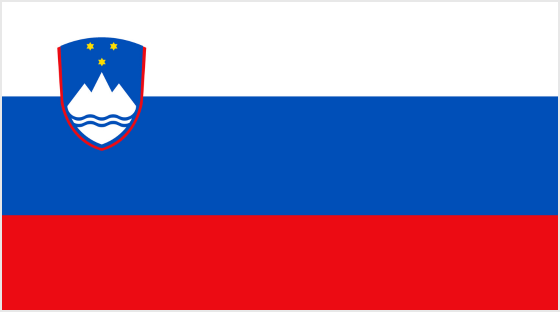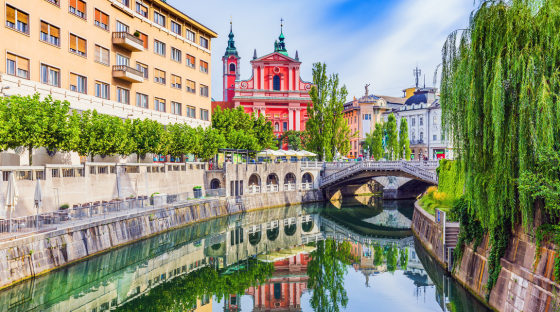Slovenia

Overview
With solid infrastructure, a well-educated workforce, and a strategic location between the Balkans and Western Europe, Slovenia is building its profile as an outsourcing destination where software development rates are in line with the high quality of skill on offer.
A stable and prosperous country, its GDP per capita is close to the European average and it is making strong progress in digitization. A recent technology EU report noted impressive strides in e-government and a strong fiber network, with 78.5% of households covered, against an EU average of 64%.
The country is renowned for its diverse landscapes and climes, alpine in the north, Mediterranean in the west and, to the east, the former Roman province of Pannonia and its thermal health resorts and vineyards. The capital is vibrant Ljubljana, home to 300,000 people, which combines the charm of a small city with the confidence of a major European center. It is a city of culture, boasting many galleries and museums and a philharmonic orchestra founded in 1701.
The Accelerance Global Network is the most curated list of high-quality global teams ever assembled.
11hrs
Time Travel (From NY)
Average flight time from NY to the major cities in the country.
70
Partner Innovation capability
The score reflects investment in STEM progrms and IT funding by country.
89
Partner Skill Level
Level of workforce skills and quality of education, including factors such as digital literacy, interpersonal skills, etc.
70
Partner Global Competitiveness
National productivity based on 12 core pillars, including government policy, infrastructure, economic stability, etc.
High
Software Outsourcing Readiness
Overall rating, based on the maturity of the tech sector, socio-political conditions, and on-the-ground research by Accelerance.

Talent Pool & Education
Described as a “true AI powerhouse”, Slovenia has a rapidly expanding ICT sector, with a growing number of international companies setting up regional hubs in the capital. In the newly released Digital Economy and Society Index, the country reached its highest overall ranking, positioning it above the European average.
With more than 3000 companies together employing more than 20,000 people, Slovenia’s ICT sector has opportunities for investment and partnerships. According to Slovenia’s Statistical Office, one in four enterprises provides training to develop e-skills, while a third of those with at least 10 staff employed ICT specialists. The current challenge is to address a situation where demand for tech professionals outstrips supply, putting pressure on wages.
A 2024 European Commission report notes recruitment difficulties highlight a critical gap in the digital labor market. Recommendations included fast-tracking new school curricula for digital skills. Education is a strong priority in Slovenia, reflected by the fact that almost half of all people aged 19 to 24 undertake tertiary education.
Language
The official language is Slovene (or Slovenian), with Hungarian and Italian recognised as co-official languages. English is widely taught in schools and spoken by about a third of the population. A high percentage of professionals, urban and younger people are likely to speak English.

Economic Outlook
With a population of 2.1 million, Slovenia is considered one of the most sustainable countries in the world, reflected by a focus on green technology in its entrepreneurial and tech startup scene. A member of the Eurozone and the EU, it has a diversified economy of which the main drivers are the automotive, consumer electronics, pharmaceutical and tourism sectors.
Over the past decade, the country has recorded an average growth rate of 2.6%, above the eurozone average. OECD forecasts are generally favorable with GDP projected to grow by 2.3% in 2024 and 2.7% in 2025, on the back of stronger domestic and external demand buoyed by employment growth and rising wages. Investment growth is expected to continue, underpinned by government spending on reconstruction following devastating floods in 2023 as well as the inflow of EU funds.
However, its strong post-pandemic recovery has been hit by headwinds from the war in Ukraine. Inflationary pressures include historically high employment and widespread labor shortages, combined with rising fuel and food prices.
Political Conditions
Since it seceded from the former Yugoslavia in 1991, Slovenia has operated a stable, multi-party, democratic political system, characterized by regular elections, a free press, and an excellent human rights record.
The Freedom Movement’s Robert Golob, a green-liberal politician and former company manager, led his fledgling party to a surprise victory over Janez Janša’s hard-right government when the country went to the polls in 2022 and a center-left coalition was formed. The shift in political winds has been seen as the rejection of what had become an increasingly authoritarian regime, creating the potential for Slovenia to act as a bridge between Western Balkan countries and the European Union.
Slovenia has strongly supported Ukraine diplomatically, financially and militarily since the invasion by Russia. In January 2024 it began its term as a non-permanent member of the Security Council of the United Nations where it has supported calls for a ceasefire in the Israel-Hamas conflict.
According to polls of voter intentions, support for the ruling Freedom Movement Party began to wane in 2023 and the conservative Slovenia Democratic Party, led by Janša – dubbed "the Slovenian Trump" by Der Spiegel – has overtaken it in popularity. The next parliamentary elections are due in 2026.
Learn more about our customer stories.
Looking for a customer story in a specific technology or industry? Discover compelling customer narratives within a specific technology or industry that resonate with your unique software development needs.


.png?width=300&name=Copy%20of%20WEBSITE%20Stop%20Chasing%20Low%20Hourly%20Rates%20Unlock%20the%20True%20Value%20of%20Offshore%20Development%20(450%20x%20253%20px).png)



